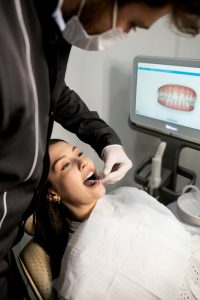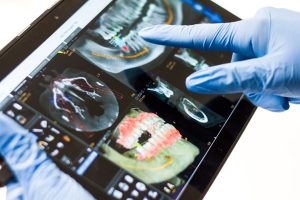Picture this: You’re reclining in a dental chair, and instead of the dentist squinting at your X-ray, a gentle beep announces, ‘No cavities!’ That’s not science fiction—it’s how AI is flipping the script in dental clinics across the country. As someone who once dreaded check-ups, I’ve witnessed firsthand how artificial intelligence makes appointments faster, less stressful, and even a bit futuristic. But trust me, the real surprises of AI in dentistry go way beyond what’s on the surface.
The New Dental Detective: How AI Sees What Dentists Can’t
In 2025, AI dental imaging technology is transforming the way you experience dental care. Gone are the days when even the most skilled dentist might miss a tiny cavity or the earliest signs of gum disease. With Artificial Intelligence dental diagnostics, your dentist now has a digital detective on their team—one that never blinks and never overlooks a detail.
Today’s AI-driven imaging software analyzes X-rays, 3D scans, and radiographs at lightning speed. Deep learning algorithms can process thousands of dental records in seconds, instantly flagging areas of concern. These advanced systems don’t just match human performance—they often surpass it. Early-stage problems, like micro-cavities or subtle bone loss, are detected long before they become visible to the human eye—even for seasoned pros.
- AI in Dental Diagnostics means you get faster, more accurate results.
- Deep learning algorithms dentistry enables early intervention for issues like oral cancers or root resorption.
- AI radiograph analysis reduces human error, ensuring nothing is missed.
- AI caries detection pinpoints cavities at their earliest, most treatable stage.
As Dr. Kevin Chan puts it:
“AI allows us to find problems before they become pain points—for both patient and practice.”
With AI diagnostic accuracy at the forefront, you benefit from data-backed decisions and peace of mind. Dentists can now show you exactly what’s happening in your mouth, using AI-powered images and clear explanations. The result? Earlier intervention, less invasive treatments, and a new level of trust in your dental care. In 2025, AI isn’t just assisting your dentist—it’s revolutionizing the way dental problems are found and solved.
Predict-and-Plan: Custom Dental Treatment, Powered by Algorithms
Imagine a dental visit where your care plan is as unique as your smile. Thanks to AI treatment planning in dentistry, that’s now reality. AI algorithms for dental treatment sift through your dental history, digital X-rays, 3D scans, and even your daily habits—like whether you’re a midnight snacker or a flossing superstar—to design a care plan tailored just for you.
Today’s AI doesn’t just help dentists diagnose; it helps personalize every step of your journey. As Dr. JC Lin puts it:
“AI doesn’t just help us diagnose—it helps us personalize each step of the journey.”
Orthodontists are leading the way, using predictive AI to map out tooth movement for braces and aligners. This means fewer unnecessary adjustments, less time in the chair, and more predictable results. In 2025, AI dental treatment prognosis is so accurate that you’ll likely need fewer appointments, reducing both treatment time and uncertainty.
- Personalized plans: AI factors in your clinical data, past dental records, and lifestyle to create a custom roadmap for complex procedures—implants, orthodontics, endodontics, and more.
- Optimized pathways: Data-rich AI models predict how your teeth will respond, minimizing repeat visits and maximizing success.
- Improved efficiency: AI-driven dental practice efficiency means streamlined workflows for your dentist, so you get care that’s both faster and more precise.
Research shows that AI-driven treatment reduces appointment numbers and overall treatment duration. For orthodontics, AI planning boosts outcome predictability and workflow efficiency, making your experience smoother and more effective. With AI patient care improvement at the forefront, you get proactive, data-backed dental care—no guesswork, just results.
Robots at the Ready: When AI Gets Hands-On
In 2025, AI-powered dental robotics are transforming the way dentists approach complex procedures. These smart machines are now trusted co-pilots for surgeries like dental implants and root canals, mapping out surgical paths with unmatched precision. While the dentist remains in control, robots steady the course, minimizing the risk of human error and ensuring each movement is calculated and safe.
With advanced AI dental diagnostics software and real-time imaging, these robots can identify the best angles and depths for incisions, making procedures smoother and more predictable. The result? Patients experience less discomfort, faster healing, and fewer complications. As Dr. Tony Liu shares,
“Patients are amazed at how swift their recovery can be with a bit of help from a machine.”
Data from recent studies shows that AI-driven robotics reduce the risk of surgical complications and contribute to shorter recovery times. For patients, this means getting back to daily life sooner—with less anxiety about the procedure itself.
But the hands-on revolution doesn’t stop at surgery. Smart dental devices and AI-integrated wearables are now part of proactive care. These devices monitor oral health habits, provide real-time feedback, and alert both patient and dentist to potential issues before they escalate. It’s a new layer of prevention that keeps dental problems at bay and supports ongoing oral health.
- AI-powered dental robotics guide surgical procedures for greater accuracy
- Robots map surgical paths, reducing “oops” moments and human error
- Faster recovery and fewer complications for patients
- Smart dental devices and AI enable proactive, personalized care
In today’s AI dental practice, robots don’t replace dentists—they empower them, boosting AI dental practice productivity and delivering a futuristic, patient-centered experience.
From No-Shows to Know-It-Alls: AI Makes Dental Visits Smarter (and Friendlier)
In 2025, AI in patient engagement and education is transforming the dental experience from the moment you book an appointment. AI-powered chatbots and virtual assistants now handle scheduling, reminders, and follow-ups, freeing up front-desk staff for genuine, human conversations. This means fewer missed appointments and a smoother, friendlier check-in process for everyone.
But the benefits of AI in dental care go far beyond convenience. With AI patient communication tools, you’re no longer left guessing about your treatment. Dentists use AI-powered digital models to show you, in vivid 3D, what your smile will look like after procedures—whether it’s braces, whitening, or implants. As Dr. Lukman Hakim shares:
“Patients love seeing their ‘future smiles’—it turns anxiety into excitement.”
This transparency builds trust and helps you make confident decisions about your care. AI-driven simulations also make treatments less mysterious, giving you a clear understanding of each step and expected outcomes. Research shows that these tools improve patient understanding and decision-making, leading to better overall results.
- Fewer no-shows: Automated reminders and easy rescheduling keep your visits on track.
- More informed patients: Digital models and AI simulations demystify complex treatments.
- Bonus oral health lessons: AI nudges you toward preventive care, not just crisis fixes.
AI in patient management fosters better communication and accountability, ultimately improving care outcomes. By streamlining workflows and enhancing engagement, AI-driven tools make every dental visit smarter, friendlier, and more effective. Now, you’re not just a patient—you’re an empowered partner in your own dental health journey.
Wildcard: Tomorrow’s Brush—How a Smart Toothbrush Outsmarted My Bad Habits
Meet my AI-enabled toothbrush: it buzzes disapprovingly when I slack off and offers real-time feedback (I swear it knows when I’m daydreaming). This isn’t just a gadget—it’s a game changer in AI in Preventive Dentistry. In 2025, smart dental devices and AI have shifted the focus from treating dental problems to preventing them outright. My toothbrush doesn’t just track how long I brush; it detects inconsistencies in my technique, flags areas I miss, and even nudges me to floss. Suddenly, skipping corners isn’t an option.
Wearable AI dental devices like these are revolutionizing how we approach oral health. Instead of waiting for cavities or gum disease to develop, AI early detection dental diseases tools analyze your brushing data in real time. If you’re flagged as ‘high-risk’—maybe you’re missing the same spot or brushing too hard—you get personalized prevention tips before problems start. This proactive approach means fewer fillings, less time in the dental chair, and lower long-term costs.
What’s remarkable is how these devices use data-driven reminders and gentle nudges to help you build better daily habits. Sometimes, it feels like my toothbrush is guilt-tripping me into better hygiene, but the results speak for themselves.
“The best dental visit is the one you never need—thanks to AI helping us stay ahead.”
The benefits of AI in dental care are clear: smarter prevention, earlier detection, and truly personalized oral health. With AI-powered smart dental devices, the future of dentistry is less about drills and more about daily wins—one buzz at a time. Tomorrow’s brush isn’t just smart; it’s your partner in lifelong dental health.
In 2025, AI isn’t just a sidekick in your dental office—it’s the mastermind behind sharper diagnoses, less invasive treatments, and a more human experience for patients and dentists alike.







